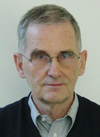| |
Götz Paschmann is one of the most
successful researchers in near-Earth plasmas and fields. In the 1970's and
1980's he and his colleagues of the Max-Planck Institute for
extraterrestrial Physics took the lead in exploring the boundaries of the
magnetosphere with various discoveries advancing the understanding of the
ways in which the solar wind interacts with the Earth's magnetic field
thereby transferring mass, momentum and energy. One of his outstanding
achievements was the first observational confirmation of the reconnection
process between the solar and the Earth's magnetic field at the front-side
magnetopause in 1979. Of similar significance are his investigations of
transient forms of reconnection in form of flux-transfer events, of the
nature and structure of magnetopause and boundary layers in dependence of
the orientation of the interplanetary magnetic field, and the
understanding of the thermalization process in supercritical
quasi-perpendicular collisionless shocks. The data base created with Götz
Paschmann's 3D plasma analyzer on the AMPTE-IRM spacecraft (1984-1986)
served until recently as a prime source of information for a wide
international community in the exploration of magnetosphere and magnetic
tail, as for instance the dynamics of substorms.
For the Cluster mission, Götz Paschmann and his
international team developed the electron beam technique for measuring
electric fields to a state permitting reliable measurements over a wide
range of external parameters in many instances complementary to the double
probe technique. Götz Paschmann is one of the experimenters who have
contributed most to our knowledge of the Earth's plasma environment.
|
